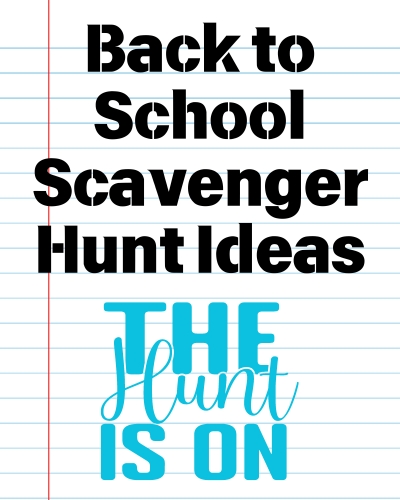- Home
- Back to School
- Back to School Scavenger Hunt
Back to School Scavenger Hunt
A Creative Start to the New School Year
Planning a back-to-school scavenger hunt can be a fun and interactive way to kick off the new school year and help students familiarize themselves with their surroundings.
These back to school scavenger hunt students are designed to promote engagement, teamwork, and a positive start to the new school year. By incorporating fun and interactive experiences into the back-to-school routine, educators and parents can create a supportive environment that inspires learning and fosters a sense of excitement for the year ahead. Students are sure to enjoy participating in a back to school scavenger hunt.
Back to School Scavenger Hunt Ideas
Inside the Classroom
- Find your desk or assigned seat.
- Locate the classroom library and find a book you're excited to read.
- Identify where the art supplies are kept.
Around the School
- Find the principal's office and get a sticker or a high-five.
- Locate the cafeteria and identify where you can find healthy snacks.
- Find the playground and take a picture of your favorite play equipment.
Meet New Friends
- Introduce yourself to a classmate you don't know yet.
- Find someone wearing a specific color or pattern and ask them about their favorite summer activity.
- Take a picture with a new friend and write down one thing you have in common.
These scavenger hunt ideas can be customized to suit your school's layout, resources, and classroom. They encourage teamwork, exploration, and familiarization with the school environment, making back to school engaging and enjoyable for everyone.

Planning a Back to School Scavenger Hunt
Step 1: Set Objectives and Themes
Step 2: Be Creative
Step 3: Be Prepared
Step 4: Set Rules and Consider Safety
Before diving into the logistics, determine the objectives and themes for your scavenger hunt. What do you want the outcome to be for students? What do you want them to learn about and experience while participating in your back to school scavenger hunt? Consider finding specific locations (like the library or cafeteria), learning school rules, or meeting school staff they will interact with. Choose a theme that aligns with the interests of your students and ties into the educational goals of the activity.
Design clues and tasks that challenge students to explore different areas of the school while learning important information.
Here are some ideas for clues and tasks:
Find the classroom with the alphabet chart.
Locate the school library and count how many bookshelves there are.
Identify three safety signs in the school hallway.
Identify the hallway rules.
Take a photo with a school mascot.
Ensure that clues are clear, concise, and easy to understand for primary and elementary students.
Gather materials needed for the scavenger hunt, including:
Printed copies of clues and tasks.
Clipboards and pencils for each team.
Maps of the school layout (if available).
Prizes or rewards for participants.
Establish clear rules and safety guidelines to ensure a safe and enjoyable experience for all participants. Emphasize the importance of teamwork, respectful behavior, and following school rules during the scavenger hunt. Assign adult supervisors or volunteers to monitor the activity and assist students as needed.
Fun Scavenger Hunt Ideas
Classroom Exploration: Include clues that lead students to different classrooms or areas within the school. For example, "Find the classroom with a poster of the solar system."
School Rules and Safety: Incorporate tasks that reinforce school rules and safety guidelines, such as finding the location of the first aid kit or identifying emergency exit signs.
Meet the Teachers and Staff: Encourage students to interact with school staff by including tasks like "Introduce yourself to the school librarian and ask for a book recommendation."
Interactive Challenges: Include interactive challenges such as "Take a selfie with your new desk buddy" or "Find three classmates wearing different colors of shirts."

Tips for a Successful
Back to School Scavenger Hunt
Safety First: Emphasize the importance of safety during the scavenger hunt. Remind students to walk, not run, and to respect school property and rules.
Provide Clear Instructions: Explain the rules of the scavenger hunt clearly to the students before they begin. Ensure they understand how to complete tasks and where to go next.
Promote Collaboration: Encourage teamwork by assigning students to small groups or pairs. This helps build social skills and encourages cooperation.
Adjust Difficulty Levels: Tailor the scavenger hunt tasks to the age and grade level of the students. Younger children may need simpler tasks, while older elementary students can handle more complex challenges.
A back to school scavenger hunt is not only a fun and exciting activity but also a valuable opportunity for primary and elementary students to familiarize themselves with their school environment and build camaraderie with classmates. By following this guide and incorporating educational elements, you can create a memorable experience that sets a positive tone for the new school year.
Happy hunting!







